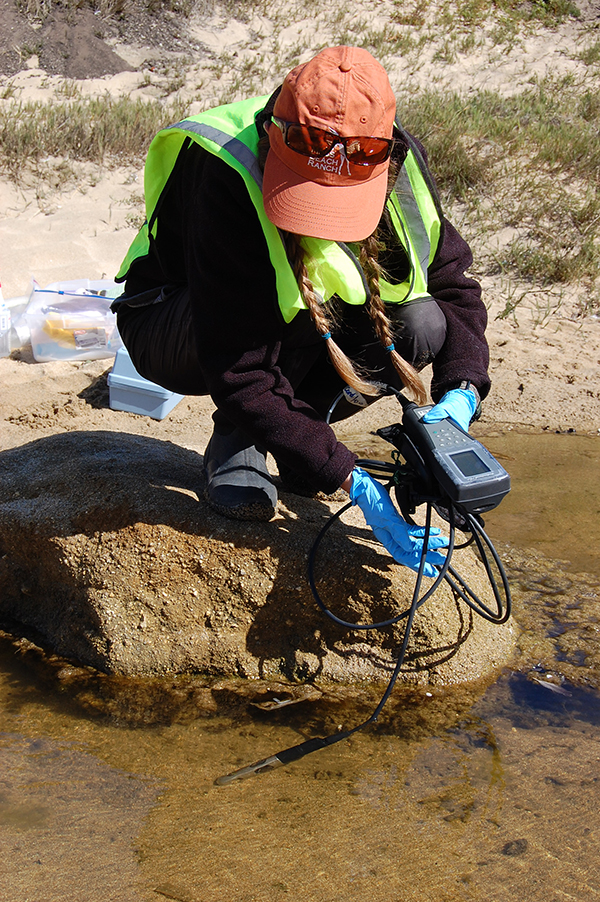Clean Water
The RCD Water Quality Program supports clean creeks, beaches and the ocean for humans and wildlife by working with property owners such as marinas, farms, ranches, parks, and homeowners to protect water quality. Work includes water quality monitoring, technical assistance, education/outreach, and identifying, planning, and implementing best management practices.
Water heroes take small actions to ensure clean water for all to enjoy. Simple choices, such as picking up pet waste in our yards and while on walks have big impacts.
Pledge to be a water hero today!
The San Pedro Creek and Pacifica State Beach Bacteria TMDL Monitoring
San Pedro Creek and Pacifica State Beach are listed as impaired water bodies on the Clean Water Act 303(d) list for bacteria, which suggest fecal contamination from warm-blooded animals such as wildlife, humans, dogs, and horses. In 2012, the Regional Water Board adopted a Total Maximum Daily Load (TMDL) which requires monitoring to better characterize bacteria contributions and to asses compliance with load allocations. The RCD implements the characterization component of this monitoring plan for the City of Pacifica and the County to help identify bacteria hot spots and which land uses/sources contribute most to impairment.
Pillar Point Harbor Water Quality Assistance
This program involves working with the San Mateo Harbor District to prevent pollution and protect water quality of Pillar Point Harbor. The RCD identifies and plans improvements to both infrastructure and operations. The RCD also monitors water quality of drainages into the harbor and analyzes past and current information to better understand sources of bacterial pollution into the harbor and recommend solutions to a variety of stakeholders.
First Flush
First Flush is the first significant rain storm of the season that washes pollutants that have built up on the landscape into creeks, storm drains, and the ocean. This program is funded by Sewer Authority Mid-Coastside and the San Mateo Harbor District and involves monitoring by volunteers during this storm to provide information about a wide variety of pollutants such as bacteria, nutrients, and metals. This program is part of a larger initiative by the Monterey Bay National Marine Sanctuary to help identify what pollutants are of greatest concern and where. We rely on volunteers to help us collect water samples.
San Vicente Creek Bacteria Water Quality Monitoring
San Vicente Creek is an impaired water body on the 303(d) list for bacteria. The San Francisco Bay Regional Water Quality Control Board developed a Water Quality improvement plan for this creek. Fitzgerald Marine Reserve, where the creek ends, has been removed from the 303(d) list. This water quality monitoring program helps characterizes bacteria and recommends best management practices to improve them.
Read the report: San Vicente Creek Water Quality Monitoring Report FY23
Other Assistance
The RCD provides a range of services related to water quality for landowners. Contact us for help with:
- Water quality monitoring and technical assistance to help inform management decisions (ex: food safety for farms, riparian fencing for ranches, regulatory compliance)
- Stormwater assistance for private properties (ex: harvesting rainwater, sustainable landscaping)
- Watershed and water quality education/outreach (ex: school programs, summer camps, workshops)
- Confined Animal Facility Technical Assistance
- Residential Low Impact Development
Resources:
- Blue Weeks Signage
- First Flush 2020 results here.
- First Flush 2019 Virtual Tour
- First Flush 2019 Results Presentation
- First Flush 2018 Results Presentation
- First Flush 2017 Results Presentation
- First Flush 2016 Results presentation
- First Flush 2015 Results presentation
- First Flush 2014 Results Presentation
- Flows To Bay: How Your Business Can Prevent Stormwater Pollution
- Pillar Point Harbor Source Identification Project
- Pillar Point Harbor Water Quality Monitoring Report 2016
- Pillar Point Harbor Water Quality Update 2017
- Pillar Point Water Quality Update October 2018
- Pillar Point Harbor Water Quality Update February 2018
- Slow It, Sink It, Spread It – RCD of Santa Cruz County
- Snapshot Day 2018 Report
- Snapshot Day Multi-Year Report
- San Pedro & Pacifica Bacteria TMDL Report 2017
- San Pedro & Pacifica Bacteria TMDL Report 2018
- San Vicente Creek Water Quality Monitoring Report FY23
- Water Quality Monitoring at Rancho Corral de Tierra Multi-Year Report (2013-2017)
RCD Contact: Jarrad Fisher
Partners: Monterey Bay National Marine Sanctuary, Golden Gate National Recreation Area, San Mateo County Harbor District, Sewer Authority Mid-Coastside, Surfrider Foundation- San Mateo County Chapter, City of Pacifica

